#legend of nibelungen
Explore tagged Tumblr posts
Note
What is Alberich King of the Dwarves (Ring: Legend of the Neibelungen) Ryu number?
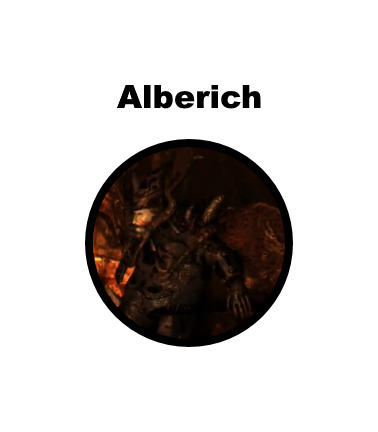
Alberich does not* have a Ryu Number.
(clarification below)
As the names suggest, Ring: The Legend of the Nibelungen and its sequel Ring II: Twilight of the Gods are based on the Richard Wagner operas that comprise Der Ring des Nibelungen, which draws from some characters of Germanic/Norse legend.
Just, you know, sci-fi.
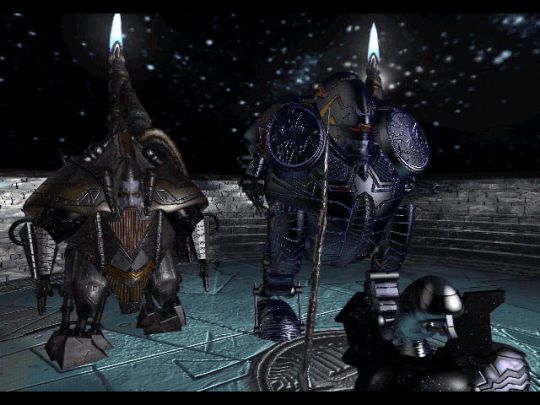
Putting aside that there may be (probably are) issues with considering the mythological figures and their Wagnerian counterparts the same, the genre shift by itself isn't necessarily so much of a departure that I'm not willing to extend that same consideration to these characters.
Combined with what I've read of some of the changes, though, that becomes a little harder for me to sign off on. Like apparently Brünnhilde/Brunhild is Siegmund/Siegfried's half-sister in the game, which from my (extremely limited) understanding of the operas is almost certainly not the case.
So push comes to shove, I'm counting the game characters as separate characters. But if you're willing to be more lenient, well,
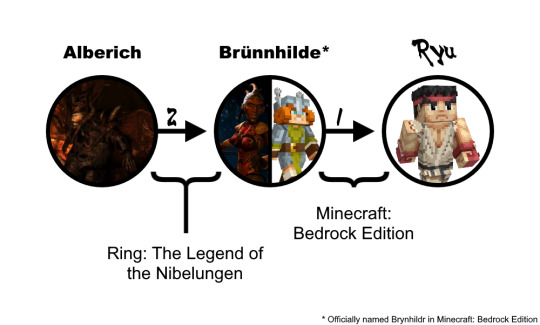
Do what you will with this. I'm pretty out of my element here.
98 notes
·
View notes
Text
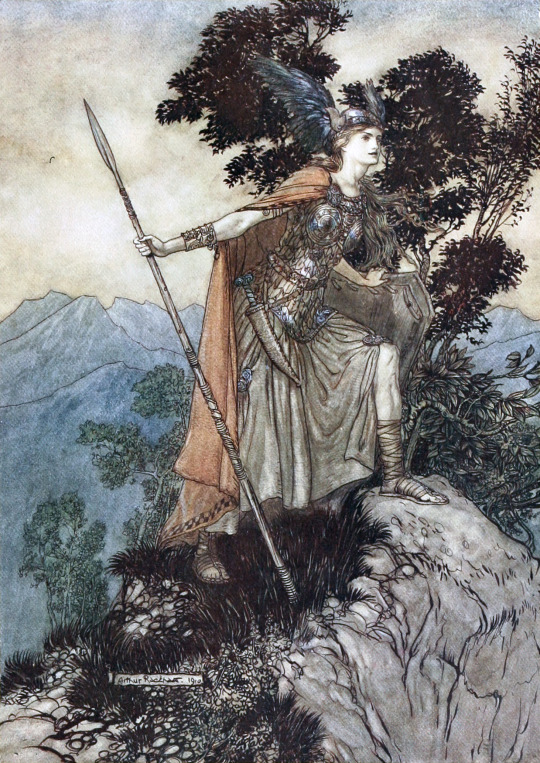
Brünnhilde the Valkyrie by Arthur Rackham
#arthur rackham#brünnhilde#valkyrie#valkyries#art#the rhinegold and the valkyrie#richard wagner#wagnerian#norse mythology#germanic mythology#brunhild#brynhildr#germanic#germanic heroic legend#shieldmaiden#der ring des nibelungen#europe#european#northern europe#nordic#völsunga saga#nibelungenlied#the ring of the nibelung#amazon#amazons#brunhilda#scandinavia#scandinavian#norse#spear
4K notes
·
View notes
Text

“Die Nibelungen: Siegfried” Peter Diamond 2018
#film poster#movie poster#poster#die nibelungen#fritz lang#siegfried#mythology#legends#peter diamond
62 notes
·
View notes
Text

UK 1998
#UK1998#CRYO INTERACTIVE ENTERTAINMENT#ARXEL TRIBE#ANNE CARRIERE MULTIMEDIA#ADVENTURE#IBM#MACINTOSH#RING THE LEGEND OF THE NIBELUNGEN
35 notes
·
View notes
Text






















"ZU NEUEN TATEN, TEURER HELDE" Götterdämmerung - R. WAGNER Here some Siegfrieds and Brünnhildes.
Peter Cornelius as Siegfried; Copenhagen, 1905
Charles Dalmores as Siegfried; Brussels, 1902
Ejnar Forchhammer as Siegfried; ?, ?
Paul Franz as Siegfried; Paris, 1925
Hans Grahl as Siegfried; Hamburg, 1934
Alois Hadwiger as Siegfried; Coburg-Gotha, 1907
Ottfried Hagen as Siegfried; Munich, 1908
Ernst Kraus as Siegfried; Berlin, ca. 1907
Gorrhelf Pistor as Siegfried; Bayreuth, 1931
Julius Pölzer as Siegfried; Munich, 1932
Erik Schmedes as Siegfried; Vienna, ca. 1910
Josef Schöffel as Siegfried; Karlsruhe, ca. 1921
Hans Tänzler as Siegfried; Karlsruhe, 1910
Jacques Urlus as Siegfried; Berlin ?, ca. 1907
Fritz Vogelstrom as Siegfried; Mannheim, ca. 1909
Hermann Winkelmann as Siegfried; Vienna, 1880
Marie Brema as Brünnhilde; London, 1897
Louise Grandjean as Brünnhilde; Paris, 1908
Felia Litvinne as Brünnhilde with Grane; Brussels, 1902
Katharina Senger-Bettaque as Brünnhilde; Berlin, 1898
Fanni Wahrmann-Schöllinger as Brünnhilde with Grane; Hannover, 1920
Hedwig Reicher-Kindermann as Brünnhilde; Leipzig, ca. 1886
#classical music#opera#music history#composer#bel canto#classical composer#aria#classical studies#maestro#chest voice#Götterdämmerung#Richard Wagner#Twilight of the Gods#Musikdrama#Der Ring des Nibelungen#The Ring of the Nibelung#The Ring Cycle#The Ring#Bayreuth Festspielhaus#Bayreuth Festival#Old Norse#Ragnarök#Norse mythology#German legends#Nordic legends#classical musician#classical musicians#classical history#opera history#history of music
34 notes
·
View notes
Text
⚠️Vote for whomever YOU DO NOT KNOW⚠️‼️


#ultimate obscure blorbo#polls#Round I#Alastair “Al” Sterling#O Human Star#Alberich#Ring: The Legend of the Nibelungen
13 notes
·
View notes
Text









"Ring: The Legend of the Nibelungen" concept art drawn by Nicolas Fructus.
18 notes
·
View notes
Text
I can't believe dragon lore legend begins is ring 2 but actually good
#dragon lore#cryo entertainment#cryo interactive#ring: the legend of nibelungen#nightblogging but not really
16 notes
·
View notes
Note
Do you think the Nibelungenlied isn't an inspiration for ASOIAF simply because you don't think GRRM has read it, or is there something in the former's themes antithetical to the latter's? A lot of what you've already said about gender and violence in the Nibelungenlied seems pretty applicable to ASOIAF from what I can tell
no no i just think he hasnt read it. he’s never mentioned it or referenced it directly and i feel like it’s kind of obscure? most people would know it from wagner’s ring cycle which is really a different story, and i feel like grrm’s talked about how most of his influences are like shakespeare and british history and arthuriana. but yes the nibelungenlied actually has pretty much identical themes to asoiaf in terms of how its characters exist in a world defined by violent structures with gender being one of those violent structures etc etc and the mask of beauty and knightly courtly ways hiding an underbelly of brutal violence and blood etc and there are a bunch of super eerie similarities between kriemhild’s baptism massacre and the red wedding. so it would make SENSE if it was somehow an influence on him but i cant prove it
#also brienne refusing to marry anyone who cant beat her in a fight seems directly pulled from brunhild. but is it? or did he get that trope#from somewhere else? who’s to say#fwiw tolkien was jnspired by nibelungen legends (mostly the edda iirc? but prob both?)
6 notes
·
View notes
Text




The Legend of Siegfried the Dragon Slayer (from Hagen - Im Tal der Nibelungen)
#siegfried von xanten#fantasyedit#jannis niewöhner#hagen im tal der nibelungen#nibelungenlied#hagen 2024#myedit
15 notes
·
View notes
Text
Since all the Oceanids in Genshin are named after real Oceanids from Greek myth, here are some of my favorite Oceanid names that I think could’ve been Furina’s name before she became the god Focalors:
Adrasteia: goddess of “inevitable fate,” representing “pressing necessity” and the inescapability of punishment. scarily on the nose for Furina’s story.
Beroe: mentioned in Virgil’s Georgics as the sister of Clio—“Clio and Beroe her sister, daughters of Ocean both, both arrayed in gold, and both in dappled hides.” Technically all the Oceanids are sisters but I like that Beroe is specifically mentioned alongside Clio, the namesake of the fictional Oceanid whose story mirrors Furina’s.
Calypso: means “she who conceals” or “like the hidden tide”
Ceto: means “sea monster” or “whale”—I like the irony of this being Furina’s Oceanid name when the prophecy is caused by a giant whale monster
Clymene: means “fame”
Eurynome: means “wanderer” or “ruler”
Galaxaura: means “calm” or “the charmer” or “like the refreshing coolness of a shady stream”
Iache: means “cry” or “shout” or “shriek”
Peitho: means “persuasion” or “winning eloquence”
Perse/Persa/Perseide/Persea/Perseis: means “destroyer”
Phaeno: means “appear” or “reveal” or “shine”; I really like the idea of Furina’s Oceanid name starting with F/Ph like her other names.
Philyra: means “linden-tree,” which is a kind of tree found in Fontaine. This tree has symbolic significance in many cultures, even being associated jurisprudence/justice in Germanic cultures. And for some big delusion, in the medieval poem Nibelungenlied—one of the inspirations for Wagner’s Der Ring des Nibelungen, from which the Dragon Sovereign King Nibelung’s name is likely derived—the hero Siegfried gains invulnerability by bathing in dragon blood, but a single linden leaf sticks to him in the process, creating his sole point of invulnerability. A fitting name for the former Oceanid who has a reincarnated Dragon Sovereign with a very big soft spot for her.
Theia: means “divine”
Urania: means “heavenly”; this is actually used in game as the name of the “Hateful Oceanid” enemy we fought during the Legend of the Vagabond Sword event, so in truth it probably can’t be Furina’s name. What makes it intriguing to me is the location on Erinnyes called Loch Urania, which is no doubt named after the Oceanid Urania, whoever she is.
#furina#genshin impact#which ones are your favorites or are there any i didn’t include you like more than these?#just used the trusty List of Oceanids Wikipedia page for this LOL
56 notes
·
View notes
Text
I'm now reading another of Heidi Anne Heiner's fairy tale collections. Sleeping Beauties: Sleeping Beauty and Snow White Tales from Around the World. Since I enjoyed Cinderella Tales from Around the World so much, I couldn't resist opening another of Heiner's books.
The first part of the book is devoted to the different international versions of Sleeping Beauty, the second part to the different versions of Snow White. This is followed by other tales of "sleeping beauties" that don't fit nearly into either category.
We start with the medieval Sleeping Beauty prototype tales from the 13th and 14th centuries.
*The earliest known prototype of the Sleeping Beauty story is the Norse and Germanic legend of Brynhild (a.k.a. Brunhild, Brunhilda, Brünnhilde, or other variations). This legend first appears in the Poetic Edda, the Prose Edda, and the Volsunga Saga from 13th century Iceland. It also appears in the German Nibelungenlied (although that version doesn't include the enchanted sleep), and its most famous modern adaptation is in Richard Wagner's four-opera cycle Der Ring des Nibelungen. The figure of Brynhild also inspired the Marvel superheroine Valkyrie.
**The Sleeping Beauty-like portion of the legend is this. The beautiful and strong-willed Brynhild is one of the valkyries, the warrior maiden servants (and in some versions daughters) of Odin (or Woden, Wotan, etc.) who preside over battlefields and bring the souls of fallen heroes to Valhalla. But Brynhild disobeys Odin by saving (or trying to save) the life of a warrior who was marked for death. (The man's identity, why he was meant to die, why she defends him, and whether she succeeds in saving him or not varies between versions.) As punishment, Odin banishes her to the mortal realm, pricks her with a "sleep thorn," and places her in a castle (or just on a rock) surrounded by a ring of fire, condemning her to sleep until a man brave enough to venture through the flames arrives to wake her and become her husband. (In some versions, she has attendants and servants who all sleep along with her.) Many years later, the fearless hero Sigurd, or Siegfried, succeeds in passing unharmed through the flames and wakes Brynhild by cutting off her valkyrie armor (or in later retellings influenced by Sleeping Beauty, with a kiss). The couple doesn't live happily ever after, however: their further adventures and eventual tragic fates are a story for another day.
**Even though it's a well-known fact that in "the original Sleeping Beauty stories," the prince (or his counterpart) impregnates the sleeping heroine and she wakes after she gives birth, no such thing happens in this earliest proto-version. If we assume that this really is the Western world's first tale of a heroine in an enchanted sleep, then it seems as if that sordid detail was a later addition.
*Next in Heiner's book come several medieval French Sleeping Beauty tales, mostly from Arthurian romances. These are the tales where we first see the motif of the heroine's love interest raping her in her sleep and fathering a child. Since few of them have ever been translated into modern English, the book simply summarizes them instead of printing them in full.
**The best-known of these stories, which most resembles Sleeping Beauty as we know it today, is the tale of Troylus and Zellandine from Le Roman de Perceforest, an Arthurian romance from 14th or 15th century France. In this tale, a knight named Troylus loves a princess named Zellandine. Then he learns that while spinning, Zellandine has suddenly fallen into a deep sleep, from which no one can wake her. With the help of a spirit named Zephir and the goddess Venus, Troylus enters the tower where she lies and, at Venus's urging, he takes her virginity. Nine months later, Zellandine gives birth to a son, and when the baby sucks on her finger, she wakes. Zellandine's aunt now arrives, and reveals the whole backstory, which only she knew. When Zellandine was born, the goddesses Lucina, Themis, and Venus came to bless her. As was customary, a meal was set out for the three goddesses, but then the room was left empty so they could enter, dine, and give their blessings unseen; but the aunt hid behind the door and overheard them. Themis received a second-rate dinner knife compared to those of the other two, so she cursed the princess to someday catch a splinter of flax in her finger while spinning, fall into a deep sleep, and never awaken. But Venus altered the curse so that it could be broken and promised to ensure that it would be. When the baby sucked Zellandine's finger, he sucked out the splinter of flax. Eventually, Zellandine and Troylus reunite, marry, and become ancestors of Sir Lancelot.
***This tale provides some answers for questions that the traditional Sleeping Beauty raises. In the familiar tale, the king, the queen, and their court know about the curse, so why do they keep it a secret from the princess? Yes, they avoid upsetting her by doing so, but the end result is that when she finally sees a spindle, she doesn't know to beware of it. Why not warn her? And why is there a random old woman in the castle, spinning with presumably the kingdom's one spindle that wasn't destroyed, and why, despite living in the castle does she not know about the curse? (It's no wonder that most adaptations make her the fairy who cursed the princess in disguise.) Yet in this earlier version, there are no such questions: no one except the eavesdropping aunt knows about the curse, because it was cast in private, so no one can take precautions against it. Another standout details is the fact that Zellandine's sleep doesn't last for many years, and that the man who wakes her already loved her before she fell asleep. Disney didn't create those twists after all!
**The other medieval French Sleeping Beauty tales are Pandragus and Libanor (where Princess Libanor's enchanted sleep only lasts one night, just long enough for Pandragus to impregnate her), Brother of Joy and Sister of Pleasure (where the princess isn't asleep, but dead – yet somehow the prince still impregnates her – and is revived by an herb that a bird carries to her), and Blandin de Cornoalha (a knight who, refreshingly, doesn't impregnate the sleeping maiden Brianda, but breaks her spell by bringing a white hawk to her side).
*All of these early Sleeping Beauty tales are just one part of bigger poetic sagas. Maybe this explains why Sleeping Beauty is fairly light on plot compared to other famous fairy tales (i.e. we're told what's going to happen, and then it does happen, and it all seems inevitable from the start). Of course one argument is that it's a symbolic tale: symbolic of a young girl's coming-of-age, as the princess's childhood ends when she falls asleep and her adulthood begins when she wakes, and/or symbolic of the seasons, with the princess as a Persephone-like figure whose sleep represents winter and whose awakening represents spring. That's all valid. But maybe another reason for the flimsy plot is that the earliest versions of the tale were never meant to stand alone. They were just episodes in much longer and more complex narratives.
@ariel-seagull-wings, @adarkrainbow, @themousefromfantasyland
#sleeping beauty#fairy tale#variations#sleeping beauties: sleeping beauty and snow white tales from around the world#heidi anne heiner#norway#iceland#germany#norse mythology#france#england#italy#tw: rape#tw: cannibalism
48 notes
·
View notes
Text
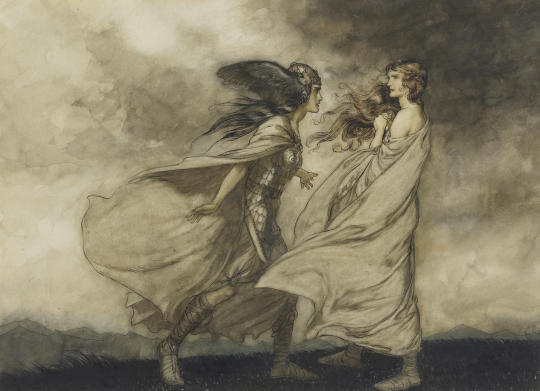
"The ring upon thy hand - ...ah, be implored! For Wotan fling it away!" Brünnhilde is visited by her Valkyrie sister Waltraute by Arthur Rackham
#arthur rackham#art#brünnhilde#valkyrie#valkyires#waltraute#siegfried and the twilight of the gods#richard wagner#the ring of the nibelung#der ring des nibelungen#germanic heroic legend#norse mythology#germanic mythology#the ring#ring#opera#europe#european#wagnerian#völsunga saga#nibelungenlied
439 notes
·
View notes
Text
Genshin Impact Timeline: Analysis and Theory (Part 1: Ancient History)

[Ancient History] [Mythic Period] [Archon War-Mondstadt] [Archon War-Liyue & Inazuma] [Archon War-Sumeru & Fontaine]
So the timeline of Genshin Impact lore is questionable at best and straight-up confusing at worst. However, I’ve been working on a fic series thingie that may never see the light of day that required me to do some digging, so here I am. I put the rest under-the-cut because it gets rather lengthy. Also this is all largely theoretical and gained from the process of analysis. I used the game itself and the Genshin Impact wiki to help me along. I will possibly add to this as updates with new information or information that corrects past misunderstandings crop up. There are definite spoilers below for pretty much all of the Genshin Impact storyline and this is a VERY long post so please beware!
The Seven Sovereigns
So, apparently at the start of everything in Teyvat, there were the Seven Sovereigns which apparently were the seven strongest elemental dragons for their respective element [Book: Byakuyakoku Collection Volume 2]. As a heads up, we do not have names for the majority of these dragons. These Seven Sovereigns had a king (who was first introduced as a plot point in Nahida’s second story quest) known as King Nibelung. (It is worth noting here that the name “Nibelung” likely comes from Wagner’s opera Der Ring Des Nibelungen but is also a name that appears in Norse legends and Germanic myths). These dragons ruled Teyvat and had elemental ‘Authorities’ until they were defeated by an individual referred to as the ‘Usurper’. It is highly implied that this ‘first usurper’ is the Primordial One. Notably, the Primordial One is often implied to be the Heavenly Principles, though, so far as I know, this has not been confirmed, though it is not a bad theory. Supporting this theory is Neuvillette’s comment that the first usurper (i.e. the primordial one) was the one who bested the seven sovereigns, while Focalors said it was the Heavenly Principles that stole the Seven Soverign’s authority. However, for the sake of simplicity, I will continue referring to this character as ‘The Primordial One’ rather than ‘The Heavenly Principles.’
The Primordial One apparently appeared out of nowhere and is highly implied to be an outlander, and as Nahida suggests at the end of the Sumeru Archon quest, the First Descender and thereby from another world, similar to the Traveler. A scribe in Enkanomiya used the name ‘Phanes’ for them and described how “the eternal throne of the heaven’s” appeared at the same time as the Primordial One [Book: Byakuyakoku Collection]. No matter where they came from though, they did battle with the seven sovereigns for what is implied to have been a lengthy period before they at long last won and, upon doing so, took part of the seven authorities from themself and their ‘4 shining shades.’ (NOTE: The best I can figure is that these ‘shades’ were created by the Primordial One from the Primordial One and are thus aspects of the Primordial One, though it is mentioned in some sources, such as the Byakuyakoku Collection, that the Primordial One would work the shades, implying that perhaps these shades were more like children, or helpers to the Primordial One.) These shades are/were able to operate separately from one another, as evidenced by Istaroth, a shade who held dominion over time and wind, coming to assist Enkanomiya when none of the other’s could hear the cries of the people of Enkanmoiya [Book: Byakuyakoku Collection Volume 2]. Additionally, these shades are implied to be of a ‘higher power’ than the Archons with Istaroth being labeled as a ‘higher power' than Raiden Makoto in Ei’s second story quest. Additionally, these shades may have even helped create at least some of the archons, as the thus far unnamed Shade of Life assisted in creating Egeria after the Sovereign Dragon of Water was defeated [Item: Fontaine Wind-Glider].
Seemingly, in the course of the forty year war between the Primordial One and the Sovereign Dragons, the Primordial one emerged victorious[Book: Byakuyakoku Collection Volume 2]. Most information states that, after the Seven Sovereigns were defeated, the Primordial One created heaven and earth in preparation for humanity [Book: Byakuyakoku Collection Volume 2 ]. Humans apparently came onto the scene approximately 400 years after the first appearance of the Primordial one and made a covenant with them [Book: Byakuyakoku Collection Volume 2 ]. The contents of this covenant are unfortunately unclear, though it is mentioned that the Primordial One had a plan for humans and that there was apparently one taboo: Succumbing to temptation. Interestingly, volume 2 of the Byakuyakoku Collection also mentions that the path to temptation is sealed. It is possible that ‘temptation’ refers to forbidden knowledge or something of that sort.
The Second One Who Came.
At some point in time, while Enkanomiya was still part of a single unified human nation that spanned the entire world and after the creation of humanity, but before the Archon war, ‘The Second One Who Came’ (also referred to as the ‘Second Throne in Heaven’) came from ‘beneath the firmament” [Book: Byakuyakoku Collection Volume 2, Artifact: Flower of Paradise Lost- the Amethyst Crown]. It is worth noting here that the second one who came is referred to as ‘Invaders’ indicating a plural group rather than a singular person in the Amethyst Crown artifact from the Flower of Paradise Lost set. It is possible that, since Apep implies Nibelung was revived or returned after defeat, that the Second One Who Came and King Nibelung joined forces against the Primordial one and that this is when the divine nails were used for the first time, but that is merely conjecture. However, we do know that King Nibelung apparently gained access to Forbidden Knowledge and seemingly introduced Forbidden Knowledge to Teyvat in an attempt to beat the Primordial One and “gain the right to shape this new world” [Nahida’s second story quest, Book: Byakuyakoku Collection Volume 2]. While The Second One Who Came ended up fighting the Primordial One for unclear reasons, this war ended up ravaging the heavens and earth, with the Primordial One apparently ending up victorious. It was during this war that Enkanomiya sank beneath the waves [Book: Byakuyakoku Collection Volume 2]. After emerging victorious from this battle, the Primordial One used Divine Nails (like the ones in Dragonspine and the Chasm) to heal the land from the damage done by the Forbidden Knowledge. This could be when the divine nails were sent into Dragonspine into the ancient civilization of Sal Vindagnyr, the Chasm, Tsurumi Island, and the Eternal Oasis. However, if that is the case, then Khaenr’iah would have been appearing around this time since the ‘Scribe’s box’ item from the Dragonspine quest mentions ‘a new nation without gods’ and Khaenr’iah is the only nation without gods that is known to have existed [The Scribe’s Box: Dragonspine quests]. Interestingly, during this war, the Primordial One’s Authority that had been initially taken from the Seven Sovereigns ended up getting damaged, making it so that they could no longer suppress the original order of the world. In order to “continue to subdue and control the resentments and loathing of this world,” the Primordial One was forced to create the gnoses with the assistance of someone referred to as ‘the one who came after’ [Neuvillette’s Character Story: Vision]. It is worth noting here that it is unclear if ‘the one who came after’ is the second one who came or yet another descender, possibly the third one whose body has been suggested to have formed the gnoses [Fontaine Archon Quest]. Interestingly, the people of Enkanomiya did attempt to return to the surface, which is when they learned the Primordial One had been victorious. However, they also learned that the Primordial One had supposedly placed a ban that sealed Enkanomiya from the surface. An NPC in Enkanomiya called Eboshi asserts that the Primordial One/Heavenly Principles did not want anyone who knew the true history of the world to be on the surface, hence the ban. However, the ban is only referred to as a ‘heavenly order’ and the Second One Who Came was apparently connected to the heavens as well, meaning the order may have come from them rather than the Primordial One.
#Genshin Impact#Genshin#analysis#theory#Genshin analysis#Genshin theory#mywritings#Mondstadt#Liyue#Inazuma#Sumeru#Fontaine#Khaenr'iah#the seven sovereigns#sovereign dragons#lore#Genshin impact analysis#Genshin impact lore#Enkanomiya#Dragonspine#The primordial one#Heavenly principles#the second one who came#celestia#gnosis#gnoses#Nibelung#Authorities
18 notes
·
View notes
Text
Day 1
How did I first discover the Nibelungenlied?
So I'm doing the 30 days Nibelungen challenge by @haljathefangirlcat, despite it being already eight years old - just for fun.
Well, my first response might be a bit underwhelming, since I honestly don't really remember, how I first discovered the Nibelingenlied. Must have been in my early teens.
I got into norse mythology when I was 12 (after watching the first Thor movie xD) and probably got into german heroic legends not long after that. And fell in love with the Nibelungenlied in particular.
7 notes
·
View notes
Text



















"NUN ZÄUME DEIN ROSS, REISIGE MAID!" DIE WALKÜRE - R. WAGNER (2 act)
Here some Brünnhildes
Mathilde Fraenkel-Claus as Brünnhilde; ?, (ca. 1902)
Marie Burk-Berger as Brünnhilde; Munich, 1907
Lucienne Breval as Brünnhilde (print); Paris, 1892
Berta Morena as Brünnhilde; Munich, 1907
Emmy Hoy as Brünnhilde; Kiel, 1912
Maria Maier as Brünnhilde; Mainz, ?
Maria Gembarzewska / Maryla von Falken as Brünnhilde; Munich, 1913
Helena Forti as Brünnhilde; Dresden, 1913
Loni Meinert as Brünnhilde; Mannheim, 1914
Gabriele Englerth as Brünnhilde; Wiesbaden, ca. 1915
Theo Drill-Oridge as Brünnhilde; Hamburg, ca. 1923
Helene Wildbrunn as Brünnhilde; Vienna, ca. 1923
Elsa Alsen as Brünnhilde; New York, 1926
Eugenie Burkhardt as Brünnhilde; Dresden, 1926
Nanny Larsén-Todsen as Brünnhilde; Bayreuth, 1927
Olga Haselbeck as Brünnhilde; Budapest, (ca. 1930)
Henriette Gottlieb as Brünnhilde; Berlin, 1930
Frida Leider as Brünnhilde; Berlin, ca. 1934
#classical music#opera#music history#bel canto#composer#classical composer#aria#classical studies#maestro#chest voice#Die Walküre#The Valkyrie#Musikdrama#Richard Wagner#Der Ring des Nibelungen#The Ring of the Nibelung#Norse mythology#Völsunga saga#Poetic Edda#German legends#Nordic legends#the Ring cycle#classical musician#classical musicians#classical history#opera history#history of music#historian of music#musician#musicians
19 notes
·
View notes